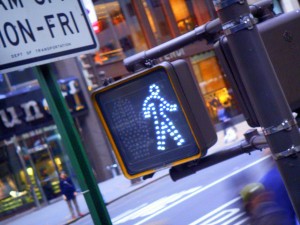What if cars came with a Surgeon General’s warning like the ones that come on cigarette packs: "Sitting in this seat could lead to obesity, diabetes, heart disease, depression, and divorce."

Surgeon General Regina Benjamin is getting ready to go halfway there. She announced in December that she’d be issuing a call to action on walking sometime in 2014. Yesterday, she and the Centers for Disease Control and Prevention asked for help crafting the call.
The CDC opened a docket yesterday to solicit information from the public “on walking as an effective way to be sufficiently active for health.” That information will be used as part of the call to action.
The wording is notable. The CDC is making the case that even if walking is the only exercise you do, it could be “sufficient” to stay healthy. It echoes the recent findings of Australian researchers, who concluded that going to the gym isn’t as effective as active transportation at keeping weight off – largely because it’s easier to work exercise into your day when it accomplishes two goals at once.
What the CDC is trying to do is identify not only what government agencies can do, but what civic organizations, health care providers, educational institutions, worksites, industry, and others can do to provide access to "safe, attractive and convenient places to walk (and wheelchair roll)."
The CDC is off to a good start even before the public chimes in with its collective wisdom. The request for public comment laid out the scope of the problem:
Less than half (48 percent) of all U.S. adults meet the 2008 Physical Activity Guidelines… and less than 3 in 10 high school students get at least 60 minutes of physical activity every day. Only 13 percent of children walk or bike to school, compared with 44 percent a generation ago. More than a quarter of trips made by car are within one mile of home.
The CDC also highlights population groups with lower activity levels:
Physical activity levels decline with age; activity levels are lower in low-income communities and among racial/ ethnic minorities; and, in general, persons with disabilities are less active than those without disabilities.
The agency acknowledges that it’s not just an exercise promotion campaign – it’s about changing the built environment:
Causes for lower physical activity levels vary but may in part be due to a lack of available and/or accessible places for safe and enjoyable physical activity.
And the request for information calls attention to walking as a form of transportation, not just exercise:
Walking can be an enjoyable recreational, occupational or purposeful (e.g., for transportation) physical activity in which many Americans can engage. It can enhance health and quality of life and can also serve as a gateway to other enjoyable types of physical activity.
Having laid out the problem, the CDC is looking for help on the solution. They're requesting information from the public on “evidence-based strategies” for breaking down barriers to walking and “community walkability” for people of all ages who don't get enough exercise. They're especially interested in helping people with developmental and chronic disease-related disabilities to be more active, and also "groups having health and physical activity disparities or lack resources and opportunities to be physically active" -- racial and ethnic minorities and low-income communities.
You have until Tuesday, April 30 to submit a comment. (Instructions are available in the docket.) If you do, please copy it into the comment section here as well -- we'd also like to hear new ideas for solving this persistent problem.




